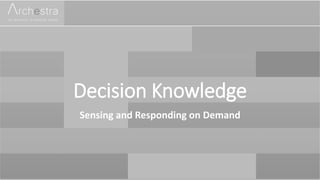Decision Knowledge: Sense and Respond
1. The document discusses decision making and the factors that influence it. It distinguishes between underlying conditions, which are the actual pre-existing causes and effects, and perceived conditions, which are the states recognized as factors that need to be addressed in making a solution or decision. 2. Decision makers are held responsible for the consequences of their decisions, which leads them to calibrate decisions to make the consequences acceptable. However, there is not always more than one justifiable decision to make. 3. The level of certainty in a decision depends on whether the underlying conditions prevent effective perception from guiding solutions. Different decision makers have different knowledge and opportunities to make the same decision.

Recommandé
Recommandé
Contenu connexe
Tendances (6)
Similaire à Decision Knowledge: Sense and Respond
Similaire à Decision Knowledge: Sense and Respond (20)
Plus de Malcolm Ryder
Plus de Malcolm Ryder (20)
Dernier
Dernier (17)
Decision Knowledge: Sense and Respond
- 1. Decision Knowledge Sensing and Responding on Demand
- 2. Solution Logic A problem has a scope of impact • A solution is appropriate to the scope • A method produces a solution • A decision selects a method • An assessment generates a decision • Evidence supports an assessment • Observable effects constitute evidence • Influences create effects • Causes have influence
- 3. What do we KNOW about conditions? What causes have effects? What effects are recognized? How are effects recognized? What constrains recognition? Why does the constraint exist? Decision makers are held responsible for the consequences of their decisions. That provokes calibrating decisions to make consequences acceptable. But it is not a given that there is ever more than one decision to make that is justifiable. The key issue in decision-making is how its justification is accountable. Different decision-makers, having differing types and amounts of knowledge, thereby have differing opportunity to make the same given decision.
- 4. Under demand, conditions drive decisions • Underlying (“natural”) conditions are the effects and causes that were already active before any responsive engagement or interventions occur, regardless of any given party’s perception. • Separately, Perceived (“apparent”) conditions are the states that are distinguished and recognized, for whatever reasons, as being factors that should be addressed or managed to allow a solution to be used. underlying perceived events presence behavior influence persistence constraints
- 5. What do we DO about conditions? Do underlying conditions prevent perception from guiding effective solutions (decisions)? Are underlying conditions distinguishable from perceived conditions? Is perception of conditions improvable during decision-making? How do we progress from less certainty to more certainty supporting the decisions? Does the decision need to alter the underlying conditions? Decision makers are held responsible for the consequences of their decisions. That provokes calibrating decisions to make consequences acceptable. But it is not a given that there is ever more than one decision to make that is justifiable. The key issue in decision-making is how its justification is accountable. Different decision-makers, having differing types and amounts of knowledge, thereby have differing opportunity to make the same given decision, whether a better one or not..
- 6. Underlying versus Perceived Conditions (Generic) Category Definition Underlying (actual) aka natural Perceived (apparent) aka circumstantial A priori level of decision certainty Unmitigated affect on decision confidence Mitigator to apply Chaotic has no recognizable structure Ephemeral Formless Very low High difficulty, and decisions have only temporary value, for unknown timespan Reflexes Random Unregulated Volatile Unconstrained Confused has no unambiguous identity Unpredictable Ill formed Medium low Significant difficulty, and sorting through confusion is resource- intensive Focus Incoherent Irregular Unsteady Poor Complicated includes arbitrarily connected elements Inconsistent Ill formed Low Circumstantially risky, according to outcomes required and/or known precedents Models Inefficient Idiosyncratic Steady Loose Complex depends on multiple elements interacting Consistent Formal Medium high Circumstantially easy or difficult according to readability Analysis Coherent Regular Steady Sensitive Simple depends on single active element Stable Formal Very high High ease Practice Predictable Standard Constant Definitive Actual: events behavior persistence Apparent: presence influence constraints © 2014, 2021 malcolm ryder / archestra research
- 8. Archestra notebooks compile and organize decades of in-the-field empirical findings. The notes offer explanations of why things are included, excluded, or can happen in certain ways or to certain effects. The descriptions are determined mainly from the perspective of strategy and architecture. They comment on, and navigate between, the motives and potentials that predetermine the decisions and shapes of activity as discussed in the notes. As ongoing research, all notebooks are subject to change. ©2021 Malcolm Ryder / Archestra Research ©2021 Malcolm Ryder / Archestra Research www.archestra.com mryder@archestra.com
